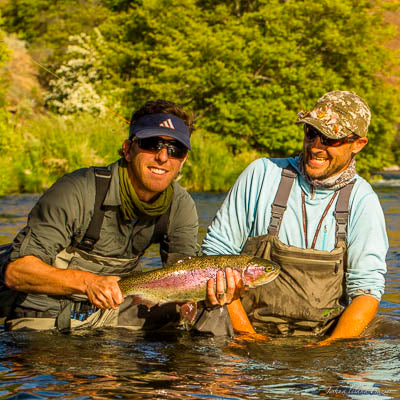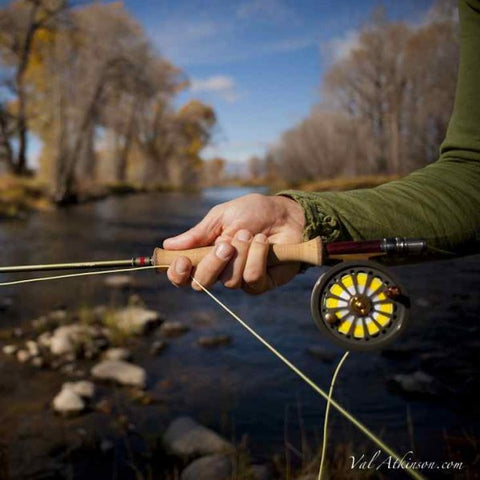
What is Fly Line?
Fly line is a common term for the weighted line that, in conjunction with a fly rod and reel, delivers the relatively weightless fly fishing lure, or fly, to the targeted game fish in the sport of fly fishing. As described by the 17th Century fly angler and writer, Sir Izaak Walton, and others, fly fishing line originated as spun or braided lengths of natural silk. Although these early silken fly lines were quite effective, they were not known for their ability to cast flies long distances or for a lasting overall durability.
Since fly fishing’s earliest period of development, fly line has grown and morphed into a highly sophisticated component of an angler’s tackle strategy. Today, fly lines are available in a wide range of styles and designs; the prevailing theory in modern fly fishing is to match the functional design of a fly line with distinct fishing situations and/or targeted fish species.
Accordingly, there are several common varieties of fly line: full-floating fly lines, partial-float fly lines, sinking fly lines of varying sink rates, full-sinking lines, and a range of specialty lines that are too numerous to mention. The most commonly utilized fly line type, however, is the full-floating line, a line designed to sit atop the water’s surface for the full length of the line. Full-floating lines are often referred to informally as “full-floaters” and are the best choice for all-round fishing situations and are perfect for the execution of classic dry fly fishing techniques.

MODERN FLY LINE CONSTRUCTION
Today’s fly lines range in length from 80 to 105 feet and are constructed of a single-stranded, spun, or braided synthetic core material and a high-tech plastic coating. The stiffness of the core material is of paramount importance when considering the climate of your fishing destination. Softer and more supple materials are perfect for colder weather, while stiffer braids excel in warmer climates. Selecting the right core stiffness will ensure that loose loops or tight coils between your guides will not hamper your cast.
Floating fly fishing lines are able to actually float because they are less dense than water. During the construction of a floating fly line, hollow microspheres imbedded in the PVC plastic coating, lowering the overall density of the line while maintaining the line’s unique shape or “taper.” Sinking fly lines are more dense than water and are constructed in the opposite way than floating lines. A sinking line’s construction generally employs a coating of varying amounts of tungsten mixed with the plastic. Different ratios of PVC to tungsten yield different sink rates, a technology that has created a new market for highly specialized sinking lines, especially for striped bass and steelhead fly fishing which often require the use of sub-surface streamers, wet flies, and nymphs for successful results.
FLY LINE WEIGHT
Fly lines range from the very thinnest and lightest for making short casts with tiny flies with tiny rods on small water, up to the heaviest, thickest fly lines designed to cast over-foot-long, massive flies with powerful big-game fly rods to catch giant fish in the ocean. All fly lines are numbered, on a universally accepted scale, by the physical weight of the first 30 feet of the forward, delivery end of the fly line; the bigger the number, the heavier the fly line. Fly rods are numbered in the same way, to balance the proper line weight with the rod’s relative flex or stiffness. The heavier the fly line, and the respective fly rod, the greater the capability of casting larger flies, combatting the effects of wind, and, up to a point, casting greater distances. So, in a sense, the fishes that we pursue actually determine what line weights we anglers use to catch them. The fish prefers natural foods of a certain size range, and we try to select the line weight that is best able to a cast our hand-tied imitations of that food in a manner that, hopefully, won’t scare the fish.
The smallest fly lines are the ultra-light lines, all floating, a category created in recent years for those that enjoy fishing with the lightest tackle conceivable. Ultra-light fly lines range from the tiniest, 3/0, or ‘000’, to ‘0’ or zero. From there, fly lines are numbered by weight from ‘1’ to ’15’. Line weights 1 to 3 are still pretty “light” and are generally used by anglers that fish primarily on sheltered, small water with small flies.
Most trout fly anglers prefer to use either a 4, 5, or 6 weight fly line, and the correctly matched fly rod, for most of their all-around trout fishing. The 4 weight would be for an angler that fishes small to medium water with smaller flies. The 5 weight line and rod combination is the most popular, by far, and should be considered the all-around choice for fishing most sizes of trout flies on most trout water. The 6 weight line and rod may benefit trout anglers fishing larger rivers, in wind, or casting larger weighted nymphs and bigger dry flies.
Although these categories are somewhat arbitrary, as all anglers have their individual sense of technique and style, some other general recommendations would be 6 or 7 weight for smallmouth bass, 7 to 9 weight for largemouth, 7 to 10 weight for steelhead and salmon, and 8 to 10 weight for striped bass. Although some saltwater light tackle enthusiasts are now picking up the 6 weight, most saltwater flats folks use 7 to 10 weights for speckled trout, redfish, bonefish, permit, and many other small to medium salt water species. The 11 to 15 line weight category is in the realm of giant ocean critters, from fifty to several hundred pounds. The bigger line weights, once again, are for casting progressively larger flies.
FLY LINE TYPES
Weight Forward Fly Lines
Most trout fishing and other typical fly fishing situations call for a floating, weight forward fly line. These tapers are designed to carry the greatest mass at the front of the line, exploiting the laws of physics to send casts outward and load rods quickly and easily. Weight forward tapers are the most versatile of the bunch, covering fishing situations requiring everything from delicate dries to monstrous blue water flies. Depending on application, the length of the head on weight forward tapers varies widely, from massive, thick bass tapers under 28′ in head length that turn over huge, wind resistant flies, to long belly steelhead lines with heads over 65′ in length to allow line control at greater distances. However, most freshwater and saltwater anglers use weight forward fly lines with head lengths from 30′ to 45′.
Shooting heads
Shooting heads are very short fly lines, 24′ to 41′ in length, designed to be cast, or “shot,” the greatest distances using fast action fly rods with minimal false casting and minimal backcast room. The shooting head is attached, usually by a loop-to-loop connection for a quick, convenient exchange, to a thin running line that has minimal surface contact with the fly rod guides, thus achieving the long distance casts. When considering the geometric taper of a shooting head, think “cannonball at the end of a string.” Shooting heads are also usually designed to sink, and a selection of various densities allow the angler, with one reel and spool, to fish a variety of water depths and water speeds. Shooting head systems are most often used by steelhead and salmon anglers, with either single-handed and Spey rods. Lake fly anglers as well as striper fly fishers will also benefit from casting a shooting head system.
Spey Lines
Spey Fly Lines are used with Spey, or double handed rods. Spey rods range from 11′ to over 18′ in length and the most powerful of these, in the hands of an expert, are able to unleash casts sometimes approaching 200 feet! Spey rods are typically seen on steelhead and salmon rivers, but the recent leap in the popularity of Spey casting and fishing finds them on trout rivers, lakes and saltwater, as well. Spey fly lines are much thicker and heavier throughout their taper, can be longer than their single-handed cousins and have their own numbering system; so an 8 weight Spey line, for example, is a lot bigger than an 8 weight standard, or single-handed fly line. There are many styles of Spey casting that exist today. For traditional Spey casting, making longer, fixed distance, D-loop casts choose a longer belly (57 – 71′ head length) spey line such as the RIO PowerSpey. The Scandinavians have developed their own overhead casting method of Spey using very fast action rods and very short (31 – 40′), shooting head Spey lines attached to thin running lines.
Currently, the most popular Spey lines used in the States have head lengths, more or less, (34 – 56′) that fall between these two previous categories. The RIO Skagit and Windcutter lines are considered by many to be the easiest of the Spey lines to learn with and are also preferred by the majority of experienced Spey anglers to match the conditions encountered on many North American steelhead rivers. The utmost in Spey versatility, however, is offered by a fly line system with interchangeable floating and sinking tips when Spey casting in a variety of conditions.
Sinking Fly Lines
There are two main categories of sinking fly lines: sink-tips and full-sinking lines. Sink-tips are sinking lines designed to only allow the tip to sink below the water’s surface, and are quite useful for controlled subsurface fly fishing situations. Full-sinking fly lines, as the name implies, sink for their entire length. Full-sink lines are most often used for fishing flies in still water; lakes and ponds, or slow moving rivers are the favored full-sinker fishing environments. Flies cast and fished by sinking fly lines are usually retrieved, or “stripped” in by the angler to imitate prey swimming through the water. Both sink-tip and full-sink lines come in a range of densities for fishing at different depths in the water column, from a few inches below the waters surface, to over twenty feet deep.
The industry of fly fishing seems to be overdeveloping and overproducing too many product choices these days. This is very true when it comes to fly lines. To remain relevant, fly line manufacturers are creating specialty fly lines with unique tapers for just about every conceivable fishing situation. Even with good intentions, the result is an explosion of fly line choices and no clear solution for you the angler. At Leland, we’ve taken the time to cast and fish all available fly lines. We’ve assembled what we consider to be a selection of the best fly lines available today, using the criteria of casting enjoyment and fishing function.
